Transportation Needs
-
- Prospects Abound, But Where's the Money? Maritime Reporter, Jun 2002 #32
While the U.S. commercial shipbuilding industry outperformed the U.S. economy between 1992 and 2001, this period witnessed the construction of barely a dozen large ocean going vessels for our U.S. domestic trades with an aggregate cost of not much more than $500 million. In contrast, U. S. national transportation needs for the current decade will require the construction of four to five dozen such commercial vessels which, taken together with the building of smaller vessels to meet our other domestic needs, will involve shipbuilding contracts in excess of $6 to $7 billion.
The majority of this work is federally mandated by the Oil Pollution Act of 1990, or involves the replacement of vessels in our U.S. non-contiguous trades that have reached the end of their useful lives. The balance is driven by U.S. population growth and environmental concerns that are not likely to abate.
These U.S. national transportation needs are clear and immediate. However, the means for financing the vessels to meet these needs remains uncertain. During the last such period of major U.S. shipbuilding activity two important federal government assistance programs administered by the U.S. Maritime Administration (MarAd) under Title VI and Title XI of the Merchant Marine Act of 1970 (the 1970 Act) were employed to meet vessel financing needs. To date, in this decade, there has been only limited recourse to these two potentially important financing programs.
And, the Bush Administration Office of Management and Budget (OMB) has apparently targeted both of these programs for termination. What conclusions can we draw concerning U.S. shipbuilding to meet our U.S. national transportation needs for the current decade?
The U.S. Shipbuilding Scene: Vessel Needs The Jones Act and the Passenger Vessel Services Act reserve the carriage of cargo and passengers between U.S.
ports to vessels built in the United States, operated under U.S. registry and owned and operated by U.S. citizens.
These Acts protect U.S. shipbuilders from competition by foreign shipyards and provide a relatively stable maritime investment opportunity. While the world shipbuilding market is such that U.S.
shipbuilding opportunities are limited to the U.S. domestic trades, there are well documented, existing and near-term transportation needs which will provide significant building opportunities for U.S. commercial shipbuilders. The most important opportunities are those which result from the Oil Pollution Act of 1990 and the needs for double hulled vessels in our U.S. coastwise and Gulf of Mexico energy related services. These and other petroleum related requirements should provide varieties of employment which will bridge the entire spectrum of shipyard size. Supplementing this work, and of equal importance for our larger shipyards, are the ocean-going container and RoRo tonnage fleet replacements needed for our non-contiguous services, and perhaps for the initiation of coastwise feeder operations. Smaller yards should find ample supplemental employment in producing a wide variety of vessels, with perhaps the single most important subject matter being the vessels for expanding passenger and passenger/ vehicle ferry services.
-
- U.S. Shipbuilding 2003: A Congested Attempt to Fund Maritime Reporter, Jun 2003 #48
Meeting national transportation needs during the current decade should involve a surfeit of new contracts for our domestic shipbuilders. The Oil Pollution Act of 1990 (OPA 90) mandates double hulls for all vessels engaged in U.S. petroleum carriage. In our non-contiguous trades, renewal programs are
-
- Title XI: Left Out in the Cold Maritime Reporter, Mar 2003 #8
XI program was enacted in 1938 to provide a way for U.S. flag shipowners to borrow money in the private sector to build ships to meet national transportation needs. It was not a government "grant" or "give away." The shipowner purchased a MarAd contract to insure payment of the shipowner's debt to the
-
- MN 100: Marathon Petroleum Corporation Marine News, Aug 2014 #55
of company owned, chartered and operated barges. The Case: Marathon Petroleum’s Marine Transportation provides services that meet the marine transportation needs of Marathon Petroleum Company LP (MPC). Marine Transportation’s inland river fleet is one of the largest private domestic fleets of inland petroleum
-
- Container & RoRo Tonnage — Non-Contiguous Liner Trades Maritime Reporter, Jun 2002 #35
economical to allow project success. In the end, U.S. shipbuilding opportunities during the current decade will be constrained, not by transportation needs, or vessel design or shipyard capacity, but by the lack of reasonably priced capital which is likely to be dedicated to meeting national
-
- J.R. McKenzie Elected Executive VP At SCNO Barge Lines Maritime Reporter, Jun 1980 #53
vice president. Fred S. Sherman, president of SCNO, in making the announcement, stated "that the company has a long-term commitment to fulfill the transportation needs of shippers, and the promotion of Mr. McKenzie adds further depth to the SCNO organization so we may better serve our many customers
-
- New Government Statistics Show Larger, Diverse Fleet Maritime Reporter, Feb 2000 #15
fleet actually totals more than 37,000 vessels, and paints a picture of a robust and diverse fleet, with great capacity to meet U.S. shippers' transportation needs while also meeting strict U.S. environmental and safety standards. The new statistics underscore the value of the U.S. marine transportation
-
- Dixie Carriers To Build And Operate Barges For Norwegian Firm Maritime Reporter, Sep 1988 #13
in worldwide transportation. As part of its cargo consolidation program, OWLT has contracted with Dixie to handle certain domestic transportation needs involving cargoes to and from OWL Tankers at its Baytank Marine Terminal on the Houston Ship Channel, thus saving costly port time for the
-
- Great Ships of 2016: Seri Camellia Maritime Reporter, Dec 2016 #38
duct and Propeller Boss Cap Fin (PBCF). The MOSS-Type newbuilds are part of MISC’s long term fleet expansion program to cater to the energy transportation needs of PETRONAS. They have been designed for worldwide trading capability to enable them to call at all major LNG terminals in the world. MISC
-
- USCG Cutter Contract Spurs $4-Million Expansion At Tacoma Boatbuilding Maritime Reporter, Apr 1980 #28
245-foot gunboats for the U.S. Navy and 140-foot icebreaking tugs for the U.S. Coast Guard. Although current emphasis is on military and marine transportation needs, Mr. Hill sees Tacoma Boat's expanded capabilities paying off for the fishing industry as well. "Fishermen tell me that to be successful
-
- Self-Unloader For ACR Launched At Collingwood Yard Maritime Reporter, Nov 1980 #28
13 dry bulk cargo vessels principally on the Great Lakes and the St. Lawrence Seaway. The company's railway services the industrial and social transportation needs of Saulte Ste. Marie, its surrounding area and beyond. Its trucking subsidiary, Algocen Transport Holdings Limited (Thibodeau-Finch Express Ltd
-
- U.S. YARDS COULD COMPETE WITH EUROPE IN 1990s* Maritime Reporter, Dec 1989 #14
ship replacement plan, communicate this plan to shipbuilders, and accept that standard designs are the most cost-effective way to meet their transportation needs. *Editor's Note: This article originally appeared in the October 12 issue of Shipyard Weekly, the weekly publication of the Shipbuilders Council
-
 )
March 2024 - Marine Technology Reporter page: 47
)
March 2024 - Marine Technology Reporter page: 47PRODUCT, PROFESSIONAL, VESSELS, MTR BARGES & REAL ESTATE FOR SALE Marketplace INNOVATIVE. UNIQUE. PROVEN. ALLAMERICANMARINE.com ???????????????????????????????????????? 9??????????SiC A????????ArC????????????????S???????C?????????9???Ç????????? ????????????????Ý???????S???y???????????????????K???:???? MAR
-
 )
March 2024 - Marine Technology Reporter page: 43
)
March 2024 - Marine Technology Reporter page: 43Image courtesy Kongsberg Discovery Image courtesy Teledyne Marine New Products Teledyne Marine had its traditional mega-booth at Oi, busy start to ? nish. Image courtesy Greg Trauthwein offers quality sub-bottom pro? ling capability without the need tion of offshore windfarms. GeoPulse 2 introduces new
-
 )
March 2024 - Marine Technology Reporter page: 42
)
March 2024 - Marine Technology Reporter page: 42NEW TECH OCEANOLOGY INTERNATIONAL 2024 Image courtesy Greg Trauthwein Image courtesy BIRNS MacArtney launches the new ultra-compact ø12.7 mm SubConn Nano connector. Innovative connectivity built on 45 years of ? eld-proven and market-trusted design. Image courtesy MacArtney Birns celebrated its 70th
-
 )
March 2024 - Marine Technology Reporter page: 35
)
March 2024 - Marine Technology Reporter page: 35Figure 1 A self-righting vehicle design with buoyancy high and weight low, WHOI’s SeaBED AUV captures the attention of a pair of curious Antarctic penguins as it is deployed from the British research vessel James Clark Ross. Vehicle designers allowed for temperature reduction of battery capacity. Recharge
-
 )
March 2024 - Marine Technology Reporter page: 23
)
March 2024 - Marine Technology Reporter page: 23elatively inactive since 2014, the Hunga Tonga–Hunga Ha‘apai (HT-HH) submarine volcano began erupting on December 20, 2021, reaching peak intensity on January 15, 2022. This triggered tsunamis throughout the Pa- R ci? c, destroyed lives and infrastructure, and generated the largest explosion recorded
-
 )
March 2024 - Marine Technology Reporter page: 18
)
March 2024 - Marine Technology Reporter page: 18TECH FEATURE IMR There are also weaknesses in terms of accuracy because of FiGS Operations and Bene? ts signal noise and the ability to detect small ? eld gradients. In Conventional approaches to evaluating cathodic protection this process there is a risk that possible issues like coating (CP)
-
 )
March 2024 - Marine Technology Reporter page: 16
)
March 2024 - Marine Technology Reporter page: 16TECH FEATURE IMR Image courtesy FORCE Technology OPTIMIZING CATHODIC PROTECTION SURVEY USING NON-CONTACT SENSORS By Svenn Magen Wigen, FORCE Technology he principle behind sacri? cial anodes, which are water structures, reducing the need for frequent repairs and used to safeguard underwater pipelines
-
 )
March 2024 - Marine Technology Reporter page: 14
)
March 2024 - Marine Technology Reporter page: 14TECH FEATURE TELEDYNE SLOCUM GLIDERS to hold over 3.5 times as many lithium primary batteries as the the water column and its thrusters give it the ability to stay standard Slocum Glider, and to physically accommodate up to on track in strong currents or other dif? cult ocean condi- 8 different sensor
-
 )
March 2024 - Marine Technology Reporter page: 13
)
March 2024 - Marine Technology Reporter page: 13nyone familiar with glider hardware options integrated for a broad Glider answers that need,” said Shea autonomous underwater ve- range of missions. Quinn, Slocum Glider Product Line hicles (AUVs) is certainly “As the use of Slocum Gliders grew, Manager at TWR. A familiar with the popular- so did
-
 )
March 2024 - Marine Technology Reporter page: 8
)
March 2024 - Marine Technology Reporter page: 8INSIGHTS SUBSEA DEFENSE Copyright RomanenkoAlexey/AdobeStock WHEN THE SHOOTING STOPS: BLACK SEA MINE CLEARANCE WILL FEATURE ADVANCED TECH, CONOPS By David Strachan, Senior Analyst, Strikepod Systems ince the beginning of the war in Ukraine, mine warfare mines have been the weapon of choice for both
-
 )
March 2024 - Marine Technology Reporter page: 2
)
March 2024 - Marine Technology Reporter page: 2March/April 2024 On the Cover Volume 67 • Number 3 Image courtesy NIWA-Nippon Foundation TESMaP / Rebekah Parsons-King 8 Subsea Defense Black Sea Mines When the shooting stops in the Ukraine, the tough work of clearing mines will commence. By David Strachan 12 Gliders Slocum Sentinel 22 Teledyne
-
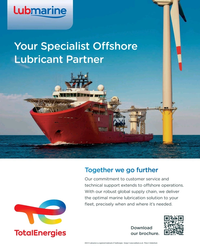 )
April 2024 - Maritime Reporter and Engineering News page: 3rd Cover
)
April 2024 - Maritime Reporter and Engineering News page: 3rd CoverYour Specialist Ofshore Lubricant Partner T Togeth her w we go o furt ther r Our commitment to customer service and technical support extends to ofshore operations. With our robust global supply chain, we deliver the optimal marine lubrication solution to your ?eet, precisely when and where it’s needed.
-
 )
April 2024 - Maritime Reporter and Engineering News page: 43
)
April 2024 - Maritime Reporter and Engineering News page: 43restraint on any haste to participation included a "Transition in er systems would include an outline reform CII until a better understanding Transportation" panel session covering of standards for secure data exchange, of the impact of changing vessel speeds how to reduce shipping’s carbon foot-
-
 )
April 2024 - Maritime Reporter and Engineering News page: 42
)
April 2024 - Maritime Reporter and Engineering News page: 42OPINION: The Final Word Seeing the Ship as a System Shipping must engage with the decarbonization realities that lie ahead by changing the way it crafts maritime legislation to re? ect its place in the interconnected, interdependent world economy, said Eero Lehtovaara, ABB Marine & Ports. ABB Marine &
-
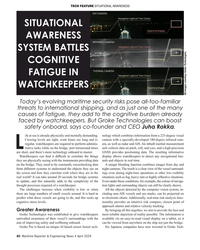 )
April 2024 - Maritime Reporter and Engineering News page: 40
)
April 2024 - Maritime Reporter and Engineering News page: 40TECH FEATURE SITUATIONAL AWARENESS SITUATIONAL AWARENESS SYSTEM BATTLES COGNITIVE FATIGUE IN WATCHKEEPERS All images courtesy Groke Technologies Today’s evolving maritime security risks pose all-too-familiar threats to international shipping, and as just one of the many causes of fatigue, they add
-
 )
April 2024 - Maritime Reporter and Engineering News page: 39
)
April 2024 - Maritime Reporter and Engineering News page: 39Tech Files Latest Products, Systems and Ship Designs “Wall Climbing Robot” Danish Pilot calls gets ClassNK Nod LEGO Model "A tribute build to a work life at sea" Image courtesy MOL, Sumitomo Heavy Industries lassNK granted its Innovation Endorse- Image courtesy Espen Andersen/DanPilot ment for
-
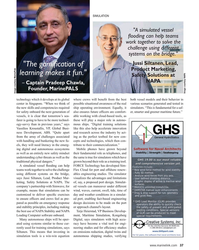 )
April 2024 - Maritime Reporter and Engineering News page: 37
)
April 2024 - Maritime Reporter and Engineering News page: 37SIMULATION "A simulated vessel ? ooding can help teams work together to solve the challenge using different systems on the bridge." – Jussi Siltanen, Lead, "The gami? cation of Product Marketing, learning makes it fun." Safety Solutions at NAPA – Captain Pradeep Chawla, Founder, MarinePALS Image
-
 )
April 2024 - Maritime Reporter and Engineering News page: 35
)
April 2024 - Maritime Reporter and Engineering News page: 35SIMULATION e have a close relationship with tech- Realism is prized beyond immersive, photo-realistic visu- nology, evidenced by, for example, als, and providers are introducing increasingly accurate func- the phones we are estimated to un- tionality. FORCE Technology’s upcoming DEN-Mark2 math- lock around
-
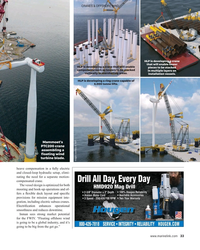 )
April 2024 - Maritime Reporter and Engineering News page: 33
)
April 2024 - Maritime Reporter and Engineering News page: 33CRANES & OFFSHORE WIND HLP is developing a crane that will enable tower HLP is developing a crane that will enable pieces to be stacked components such as towers to be stacked in multiple layers on vertically in marshalling areas. installation vessels. HLP is developing a ring crane capable of 6
-
 )
April 2024 - Maritime Reporter and Engineering News page: 32
)
April 2024 - Maritime Reporter and Engineering News page: 32FEATURE A closeup of a blade installation process taken via drone. A blade handling system is apparent (in yellow). Images courtesy of Mammoet requirement for the development of these cranes, particularly ling area. This would result in a major time and fuel saving. in ? oating offshore wind,” says
-
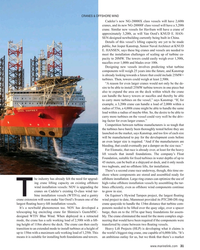 )
April 2024 - Maritime Reporter and Engineering News page: 31
)
April 2024 - Maritime Reporter and Engineering News page: 31CRANES & OFFSHORE WIND Cadeler’s new NG-20000X class vessels will have 2,600t cranes, and its new NG-20000F class vessel will have a 3,200t crane. Similar new vessels for Havfram will have a crane of approximately 3,200t, as will Van Oord’s KNUD E. HAN- SEN-designed newbuilding currently being built in
-
 )
April 2024 - Maritime Reporter and Engineering News page: 28
)
April 2024 - Maritime Reporter and Engineering News page: 28FEATURE INTERVIEW track missiles and warheads for the Mis- sile Defense Agency, and it travels with its support ship, the MV Hercules. For our Service Support ships, we have the two hospital ships, USNS Mer- cy and Comfort; two rescue and salvage ships; two submarine tenders; and the Sixth Fleet ?
-
 )
April 2024 - Maritime Reporter and Engineering News page: 27
)
April 2024 - Maritime Reporter and Engineering News page: 27RADM PHILIP SOBECK, MILITARY SEALIFT COMMAND With COVID, we had to make some hard choices for our Do your CIVMARs have upward mobility? mariners because we couldn’t rotate. Many of our mariners The Navy has Sailors who become “Mustangs,” and work found other employment, and were able to use their skills
-
 )
April 2024 - Maritime Reporter and Engineering News page: 26
)
April 2024 - Maritime Reporter and Engineering News page: 26FEATURE INTERVIEW “Over the next decade, 12 new classes of ships will come online and MSC will see up to 20 new ships deliver to the ? eet in the next ? ve years. This includes new oilers, towing, salvage and rescue tugs, and expeditionary fast transports and emergency medical ships. A large
